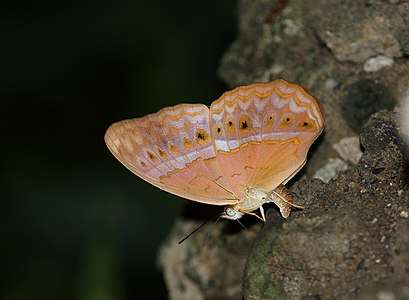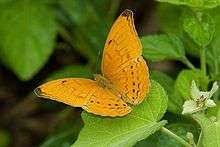Cirrochroa tyche
Cirrochroa tyche, the common yeoman, is a species of nymphalid butterfly found in forested areas of tropical South Asia and Southeast Asia.[1][2]
| Common yeoman | |
|---|---|
 | |
 | |
| Scientific classification | |
| Kingdom: | Animalia |
| Phylum: | Arthropoda |
| Class: | Insecta |
| Order: | Lepidoptera |
| Family: | Nymphalidae |
| Genus: | Cirrochroa |
| Species: | C. tyche |
| Binomial name | |
| Cirrochroa tyche Felder & Felder, 1861 | |
| Synonyms | |
| |
Subspecies
- C. t. tyche (central and southern Philippines)
- C. t. anjira Moore, 1877 (Andamans)
- C. t. aurica Eliot, 1978 (Pulau Aur, Pulau Tioman, Pulau Permanggil)
- C. t. laudabilis Fruhstorfer, 1900 (Palawan, Dumaran)
- C. t. lesseta Fruhstorfer, 1912 (southern China, Hainan and possibly Hong Kong)
- C. t. mithila Moore, 1872 (Sikkim and Assam to Indochina and southern Yunnan)
- C. t. rotundata Butler, 1879 (southern Burma and possibly Java and Sumatra)
- C. t. thilina Fruhstorfer, 1905 (Borneo)
gollark: Why did states happen in the *first* place if they aren't good and there's a stable alternative?
gollark: > Collectivization will take place naturally as soon as state coercion is over, the workers themselveswill own their workplaces as the capitalists will no longer have any control over them. This iswhat happened during the Spanish Revolution of 1936, during which workers and farmers seized andmanaged the means of production collectively. For those capitalists who had a good attitude towardsworkers before the revolution, there was also a place - they joined the horizontal labor collectivesUm. This seems optimistic.
gollark: > "Legally anyone can start their own business. Just launch a company!”. These words oftenmentioned by the fans of capitalism are very easy to counter, because they have a huge flaw. Namely,if everyone started a company, who would work for all these companiesThis is a bizarre objection. At the somewhat extreme end, stuff *could* probably still work fine if the majority of people were contracted out for work instead of acting as employees directly.
gollark: The hierarchical direct democracy thing it describes doesn't seem like a very complete or effective coordination mechanism, and it seems like it could easily create unfreedom.
gollark: I disagree with this PDF, for purposes.
References
- Wynter-Blyth, Mark Alexander (1957). Butterflies of the Indian Region. Bombay, India: Bombay Natural History Society. ISBN 978-8170192329.
- "Cirrochroa Doubleday, [1847]" at Markku Savela's Lepidoptera and Some Other Life Forms
This article is issued from Wikipedia. The text is licensed under Creative Commons - Attribution - Sharealike. Additional terms may apply for the media files.